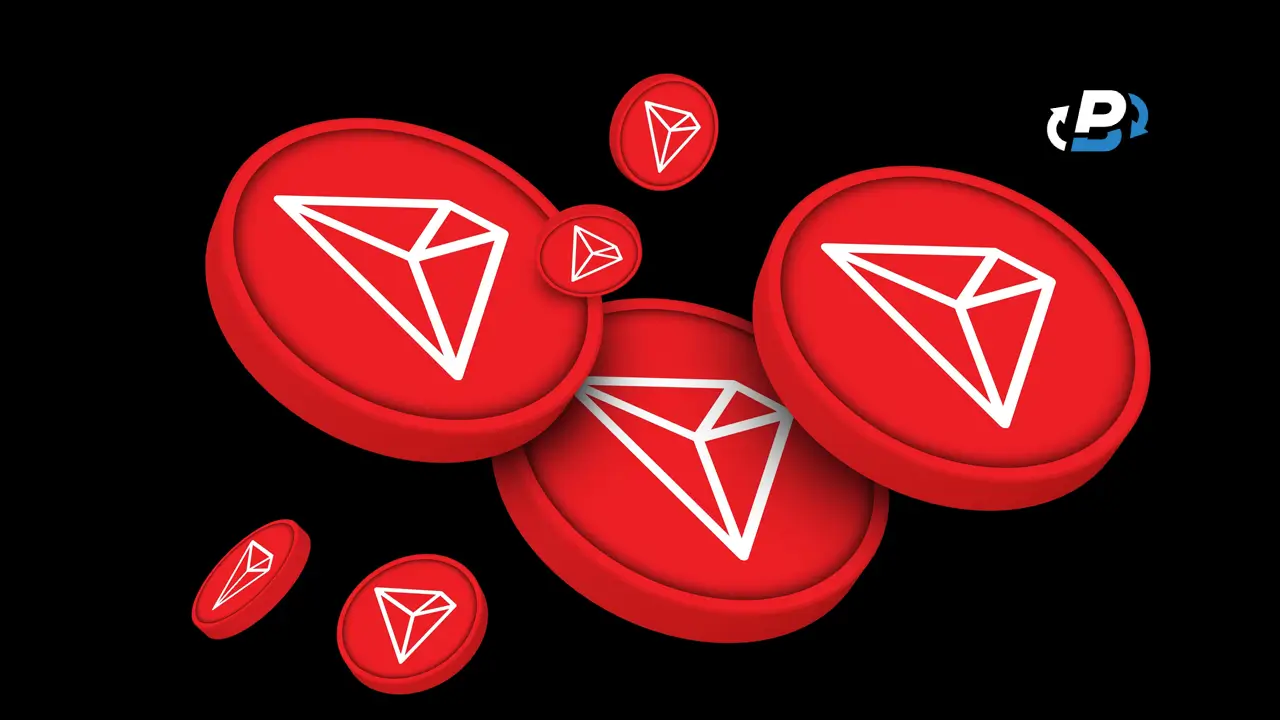A problematic topic for crypto enthusiasts to understand is the need for cryptocurrencies to pay gas fees. Often, users who want to withdraw USDT on the Tron network from Trust Wallet run into the pop-up 'You don't have enough Tron (TRX) to cover network fees'.
You encountered this error because you do not have enough TRX on the Tron Network, the token needed to make transactions and cover gas fees. This is a step-by-step guide on how to solve this issue.
You Don't Have Enough Tron (TRX) to Cover Network Fees. What's The Problem?
To understand why we cannot perform a transaction of USDT on the Tron network, we need to take a step back and understand why we need TRX to perform a transaction.
When the pop-up showing insufficient TRX to cover network fees appears on Trust Wallet, your transaction cannot be executed, as you don't have enough TRX to cover the gas fees. But why do you need to pay a gas fee? And why do I have to pay in TRX? It is imperative to dissect the implications and consequences of insufficient TRX to cover network fees.
Network Fees on Tron Blockchain
The mechanism for Tron's blockchain is the same as that of all blockchains, where transactions require a gas fee to be executed. Thus, to execute any transaction on the TRC-20 network, you must pay a gas fee in TRX, the native cryptocurrency of the Tron blockchain. But why do I have to pay in Tron (TRX)? Because Tron is a Layer 1 blockchain, the token that allows the blockchain to function is TRX. To carry out transactions with other tokens on the Tron blockchain, a gas fee must be paid precisely in TRX. Most users face this main and very common problem when sending USDT on TRC-20.
Consequences of Insufficient TRX for Network Fees
- Transaction Failures: The most immediate consequence is the inability to execute transactions. Without a balance of TRX reserved for network fees, users face transaction failures, hindering their ability to participate in the dynamic world of cryptocurrency exchanges.
- Frustration and Delays: Users encountering this challenge may experience frustration and delays executing time-sensitive transactions. The dynamic nature of cryptocurrency markets necessitates prompt decision-making, and any delay due to insufficient TRX can impact the overall user experience.
Step-by-Step Guide to Cover Network Fees on Tron
In this section, we will clarify once and for all how to solve this common problem. Once you learn all the necessary steps through this guide, you will be ready to carry out all transactions on the Tron network easily, quickly, and securely.
Step 1: Make sure your wallet supports the Tron network
Not all wallets function the same. For instance, on some wallets, like Trust Wallet, you must manually buy the various tokens you need to pay for gas dees. On the contrary, with wallets such as PlasBit wallet, the conversion for gas fees happens automatically, and there is no need to do this process.
If you use Trust Wallet, you must click "manage crypto" and add the TRX token to the Tron network. You can add the token by searching for it on the search bar and then activate it by clicking the button alongside the token.
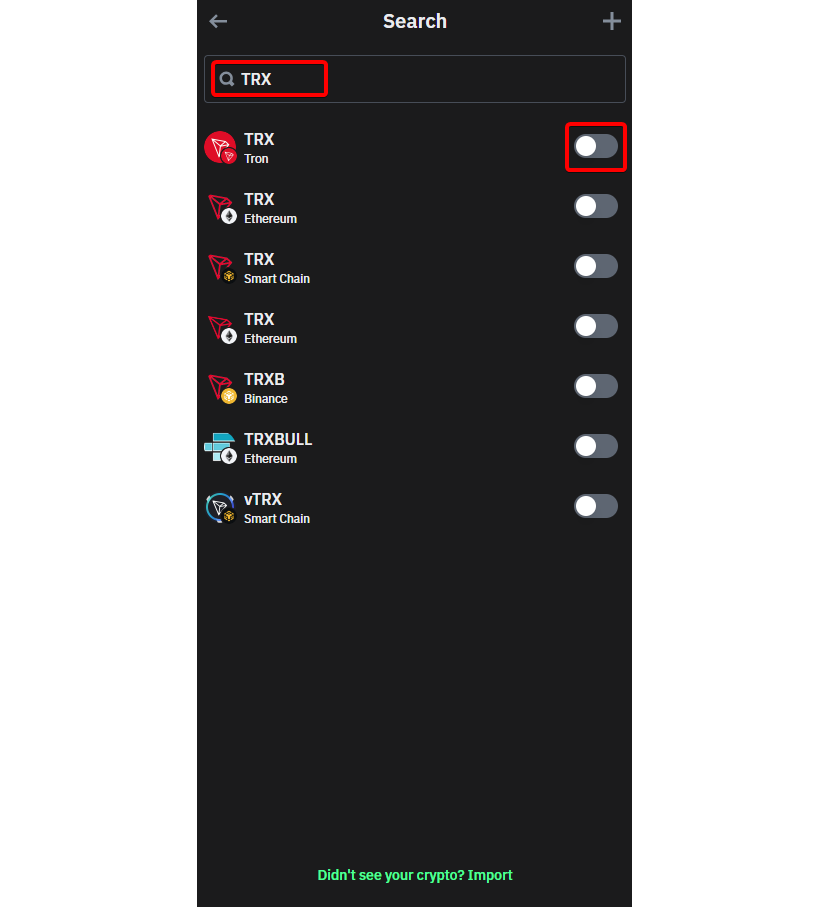
Step 2: Activate USDT on Tron Network
After adding the TRX token on the Tron network, do the same process for USDT on the Tron network, as shown in the image below.

Option A: Buy TRX on Trust Wallet
Step 1
Click on the TRX token on your wallet's homepage to start buying crypto to cover network fees.
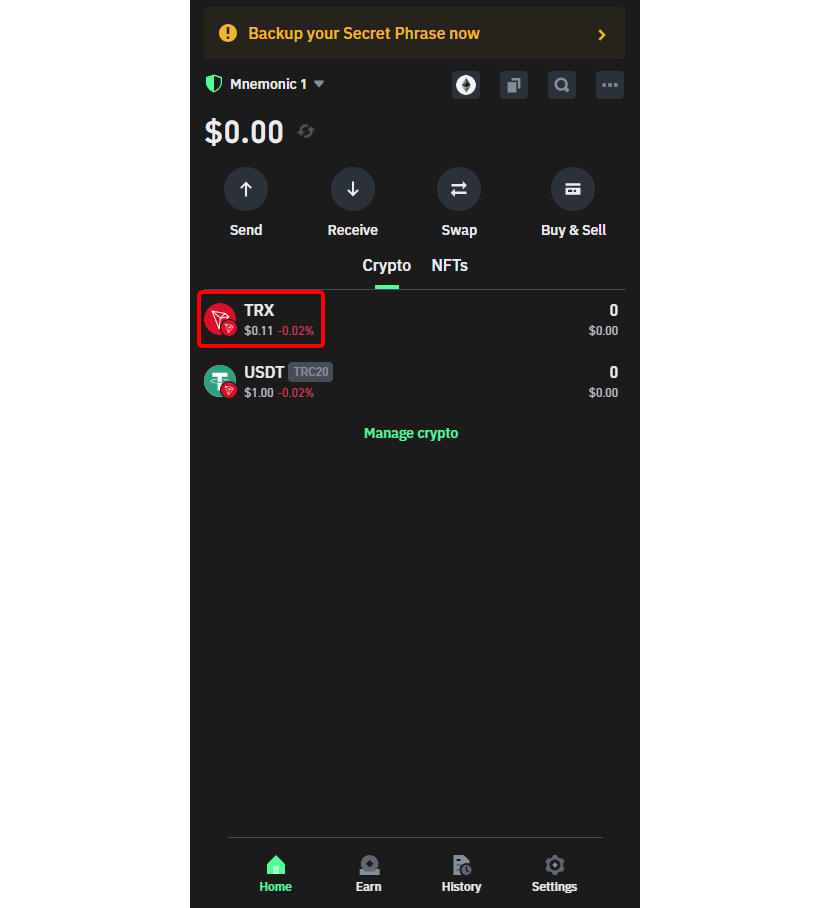
Step 2
Click on the "Buy" button to start executing the purchase. It allows you to get TRX directly on your Trust Wallet app.
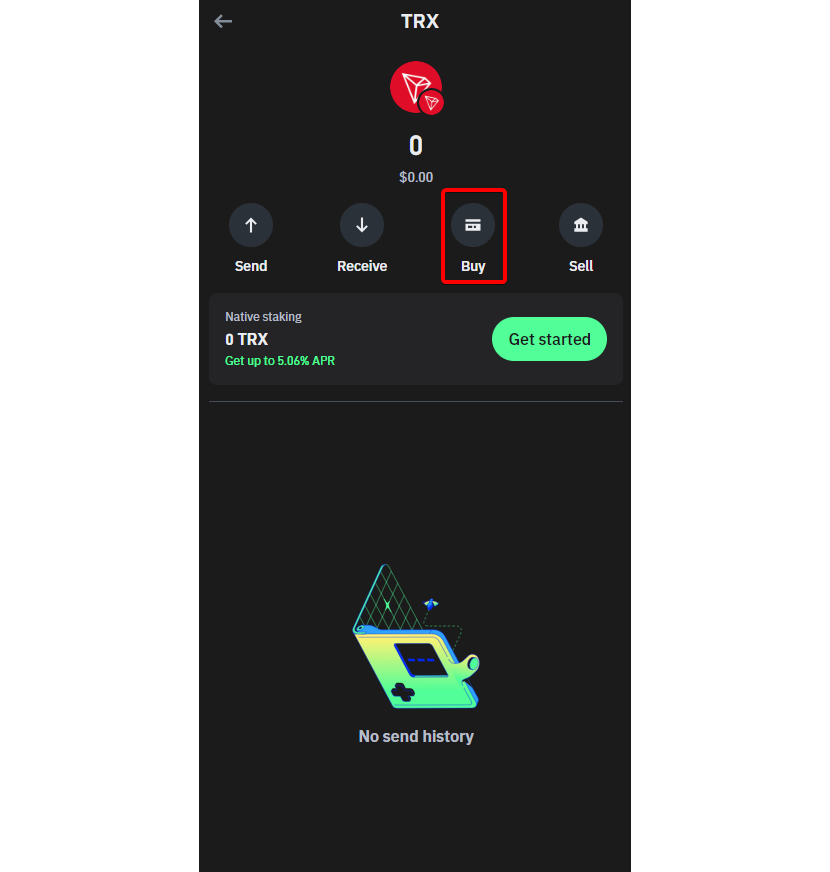
Step 3
You will be redirected to the purchase page. Here, you can choose the amount of Tron you'll buy and check all the third-party providers that allow you to buy TRX on Trust Wallet. Check their fees and commission to make a knowledgeable and informed choice: DYOR (Do Your Own Research).
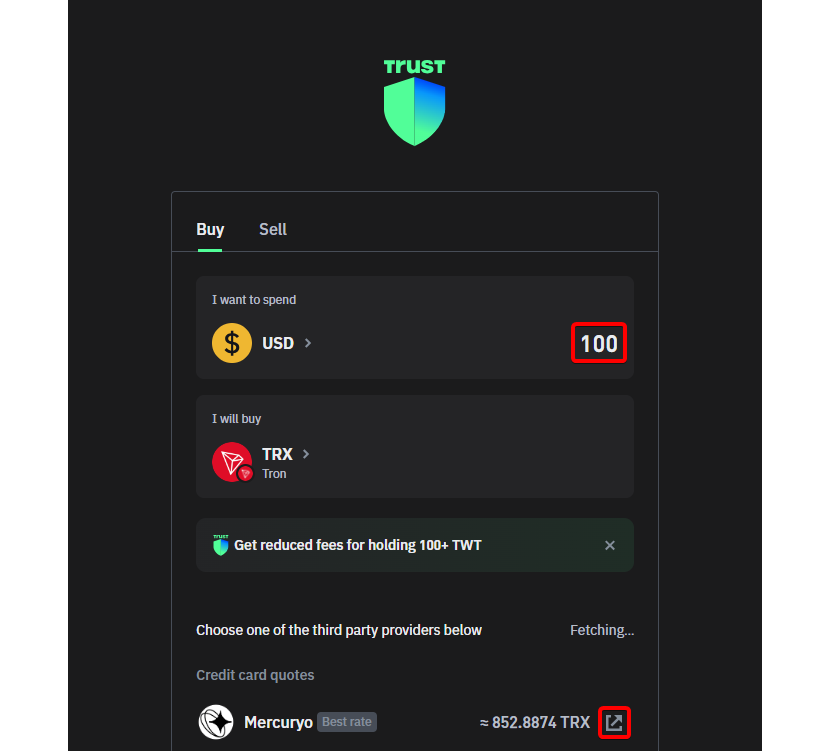
Step 4
Complete the purchase process via a third-party provider, chosen depending on your necessities and requirements.
Option B: Get TRX on a Crypto Exchange
Step 1
If you find Trust Wallet inconvenient and the fees and commissions too high, you can buy TRX on a crypto exchange like PlasBit. Do research to choose the best crypto exchange for your needs.
Step 2
Once registered and verified on the exchange, you can easily click "Wallet" to deposit crypto or fiat funds on the platform for the first time.

Step 3
Now, you have the funds to make the conversion on the exchange. Click "Exchange" to start converting your deposit cryptocurrencies to TRX.
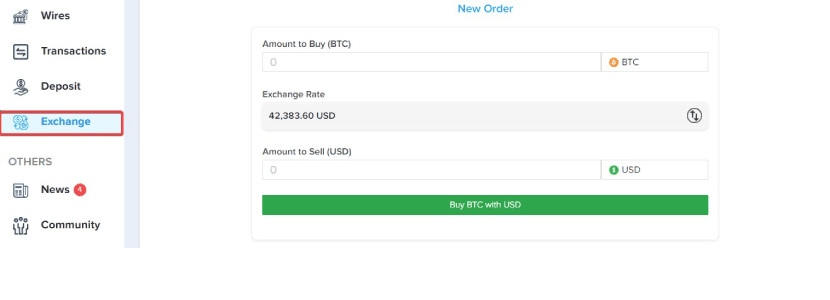
Step 4
Be sure to select the correct amount and type of cryptocurrencies. Choose TRX as the asset to receive after the conversion. Check all the data, including tokens, networks, fees, and amounts.
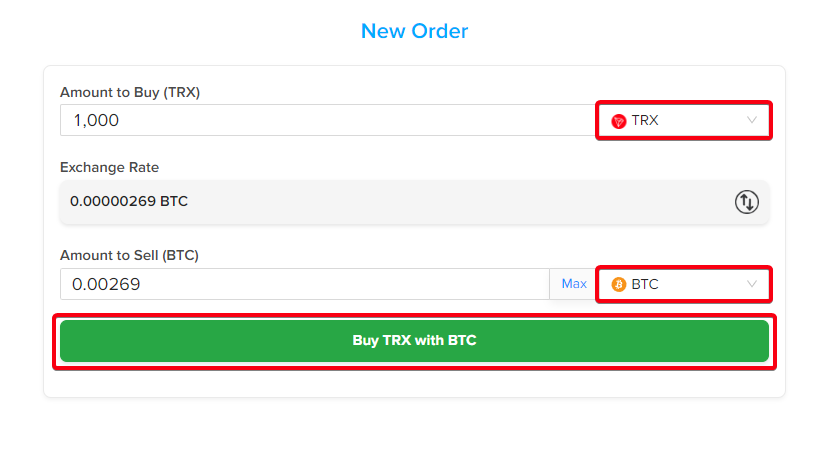
Step 5
Once you receive your Tron cryptocurrency on your exchange account, you can send TRX to Trust Wallet to withdraw your funds.

Step 6
Congratulations! You now have the necessary amount of TRX on Trust Wallet to withdraw USDT from Tron Network. Your mission has been completed!
Mitigating the Challenge: Other Strategies and Best Practices
Navigating the challenge of insufficient TRX for network fees requires a proactive approach. Users can adopt various strategies and best practices, including:
- Regular Fee Monitoring: Stay informed about current network fees and monitor changes regularly to adjust TRX allocations accordingly.
- Utilize Fee Estimation Tools: Leverage fee estimation tools provided by cryptocurrency wallets and exchanges to calculate the TRX required for fees.
- Maintain Adequate TRX Reserves: Allocate a portion of your TRX holdings exclusively for network fees, ensuring a buffer to cover fluctuations and unforeseen charges.
- Plan for Peak Usage Times: Anticipate peak usage times when network fees may rise and plan transactions accordingly to avoid fee-related challenges.
A Closer Look to Network Fees: A Common Hurdle
In the realm of cryptocurrencies, the efficiency of transactions often hinges on network fees. These fees are crucial in ensuring the timely confirmation and inclusion of transactions in the blockchain. Network fees serve multiple purposes, such as preventing spam transactions, compensating validators, and maintaining the overall security and integrity of the network.
Understanding Network Fees
Network fees, often called transaction fees, are charges imposed on users to process and validate their transactions within the blockchain network. In the context of Tron (TRX), these fees are an integral part of the transaction lifecycle, influencing the speed at which transactions are confirmed and added to the Tron blockchain.
Challenges Faced by Users
Users navigating the cryptocurrency landscape, including Tron enthusiasts, commonly encounter challenges related to network fees. The phrase "You don't have enough Tron (TRX) to cover network fees" underscores a specific predicament where users may be unable to proceed with transactions due to insufficient funds earmarked for covering associated fees.
The challenges associated with network fees include:
- Insufficient Funds: Users may not have an adequate balance of TRX to cover the required network fees, preventing the execution of transactions.
- Fee Fluctuations: The dynamic nature of cryptocurrency markets can lead to fluctuations in network fees. Users may find it challenging to predict and allocate the appropriate amount of TRX for fees.
- Transaction Delays: Transactions may face delays or remain unconfirmed when users miscalculate or overlook network fees.
Impact on User Experience
The effective management of network fees is paramount for a seamless user experience. Issues arising from inadequate TRX to cover fees disrupt individual transactions and highlight the need for a comprehensive understanding of how network fees function within the Tron ecosystem.
Case Studies: Users in Difficulty
Real-life case studies provide a tangible understanding of how users have grappled with insufficient Tron (TRX) for network fees. Examining these scenarios sheds light on how individuals have navigated and overcome such difficulties, offering valuable insights and lessons for the broader Tron community.
Case Study 1: Maria's Experience with Lack of TRX
Maria, an avid cryptocurrency enthusiast, encountered a situation where she had insufficient TRX to cover network fees due to a lack of TRX. Instead of panicking, Maria adopted a proactive approach: Maria learned the importance of understanding blockchain mechanisms and monitoring network fees. She now knows how gas fees work and is equipped with the knowledge to execute transactions on all the blockchain networks.
Case Study 2: Javier's Transaction Planning Strategy
A seasoned trader, Javier faced challenges with insufficient TRX during peak network congestion. His transactions were often delayed, impacting his trading strategy. Javier implemented a strategic approach: Javier now plans his transactions during off-peak hours to take advantage of lower network congestion. It has reduced the risk of encountering high fees and transaction delays.
Case Study 3: Emily's Advocacy for Transparent Exchanges
Emily, a community advocate, experienced issues with hidden fees on particular exchanges and ecosystems, like Trust Wallet, contributing to insufficient TRX for network fees. She took a proactive role in addressing this challenge: Emily actively engages with exchanges that offer transparent fee structures. She advocates for more precise communication about fees to empower users with the information needed for effective fee management.
These case studies underscore the importance of a tailored and proactive approach to managing network fees. Users like Maria, Javier, and Emily have overcome challenges and contributed valuable lessons to the broader crypto community.
A Brief Overview: What is Tron (TRX)?
To better comprehend the challenges associated with Tron (TRX) network fees, it's essential to grasp the fundamental nature of Tron as a cryptocurrency. Tron, founded by Justin Sun in 2017, emerged with a vision to decentralize the internet by creating a content-sharing platform on the blockchain. Unlike traditional cryptocurrencies, Tron strongly emphasizes the entertainment industry, aiming to enable direct transactions between content creators and consumers. Its key features are:
- High Throughput: Tron boasts high transaction throughput, allowing many transactions to be processed per second. This feature positions it as a viable option for those seeking swift and efficient transactions within the cryptocurrency space.
- Scalability: The scalability of Tron's network is critical to its appeal. Tron aims to accommodate the increasing transaction demand as the user base grows without compromising speed or efficiency.
- Delegated Proof of Stake (DPoS): Tron utilizes a DPoS consensus mechanism, which involves a select number of nodes, or "Super Representatives," validating transactions. This approach enhances the speed of transaction confirmations and contributes to the overall efficiency of the Tron network.
Distinguishing Factors
Tron's distinguishing factors go beyond its technical capabilities. Its focus on entertainment, content sharing, and user empowerment sets it apart in a crowded cryptocurrency landscape. By understanding these features, users gain insight into why Tron has become a prominent player in the crypto sphere.
Technological Developments and Updates
The ever-evolving nature of blockchain technology and cryptocurrency ecosystems necessitates a keen awareness of ongoing developments and updates. Within the Tron (TRX) ecosystem, technological advancements play a pivotal role in shaping the dynamics of network fees. Now, we explore recent and anticipated developments that may impact how users manage and address the challenge of insufficient TRX for network fees.
- Consensus Mechanism Enhancements: Tron, like many blockchain networks, periodically undergoes upgrades to enhance its efficiency. Changes in the consensus mechanism or improvements in processing capabilities can influence the calculation and dynamics of network fees.
- Gas Efficiency: Optimizations in Tron's smart contract execution can increase efficiency and reduce gas consumption. It, in turn, may influence the overall network fees required for executing smart contract transactions.
- Enhanced Fee Estimation: Future upgrades might introduce more accurate fee estimation algorithms, providing users with improved tools for predicting network fees. It can empower users to make more informed decisions when allocating TRX for fees.
- User Input in Fee Structures: Some blockchain networks are exploring community governance models that allow users to have a say in network fee structures. Active participation in these initiatives could lead to fee structures more aligned with user needs and expectations.
- Scaling Solutions: Integrating layer 2 scaling solutions, such as sidechains or state channels, can alleviate network congestion and reduce fees. Users may experience more cost-effective transactions, minimizing the risk of insufficient TRX for fees.
- Integrated Fee Management: Collaborations between Tron and wallet/exchange providers may result in integrated fee management solutions. Wallets and exchanges could offer advanced tools for fee tracking, forecasting, and dynamic adjustments based on real-time network conditions.
- User Guides and Tutorials: The development of comprehensive user guides and tutorials could bolster ongoing efforts to educate users on fee management. This can empower users to navigate fee-related challenges effectively.
As we explore these technological developments, it becomes evident that the Tron community is actively working towards enhancing the user experience, particularly in network fees. The synergy between technological improvements, user education, and community involvement will likely shape a more user-friendly landscape for managing Tron (TRX) network fees in the future.
Navigating the Future of TRX Network Fees
In cryptocurrency's dynamic and rapidly evolving ecosystem, insufficient Tron (TRX) for network fees underscores the need for continuous adaptation and proactive strategies. As we conclude this exploration, it's essential to reflect on the key takeaways, strategy for users, and the potential trajectory of TRX network fees. Here are some key takeaways:
- User Proactivity is Paramount: Users can significantly mitigate the risk of insufficient TRX for network fees by adopting proactive strategies, including regular fee monitoring, allocation planning, and leveraging available tools.
- Diverse Strategies for Varied Users: The case studies highlight that no one-size-fits-all solution exists. Users with different needs and preferences employ various strategies, emphasizing the importance of a tailored approach.
- Technological Advances Shape the Landscape: Ongoing and anticipated technological developments within the Tron ecosystem, such as network upgrades, smart contract optimizations, and layer 2 solutions, hold promise for addressing challenges associated with network fees.
- Community Collaboration: Active participation in the Tron community and collaboration with exchanges and wallet providers can contribute to a more user-friendly environment for fee management.
Tron’s Future Outlook
The future of TRX network fees appears dynamic and promising, with the following considerations:
- Improved Fee Predictability: Advancements in fee estimation algorithms and governance initiatives may lead to more predictable and user-friendly fee structures.
- Scalability Solutions: Integrating scalable solutions could alleviate congestion, reduce fees, and enhance the overall efficiency of the TRX network.
- User-Centric Design: Continued efforts towards user education, transparent fee structures, and integrated fee management tools can contribute to a more user-centric design, empowering TRX holders to navigate network fees seamlessly.
In conclusion, if you don't have enough Tron (TRX) to cover network fees, we've shown you three possible solutions to overcome this obstacle. Users, developers, and the broader community play crucial roles in shaping an ecosystem where managing TRX network fees becomes intuitive and accessible. At PlasBit, we hope the lessons learned today will pave the way for a smoother journey in cryptocurrency transactions as the Tron community advances toward a more robust and user-friendly future.




